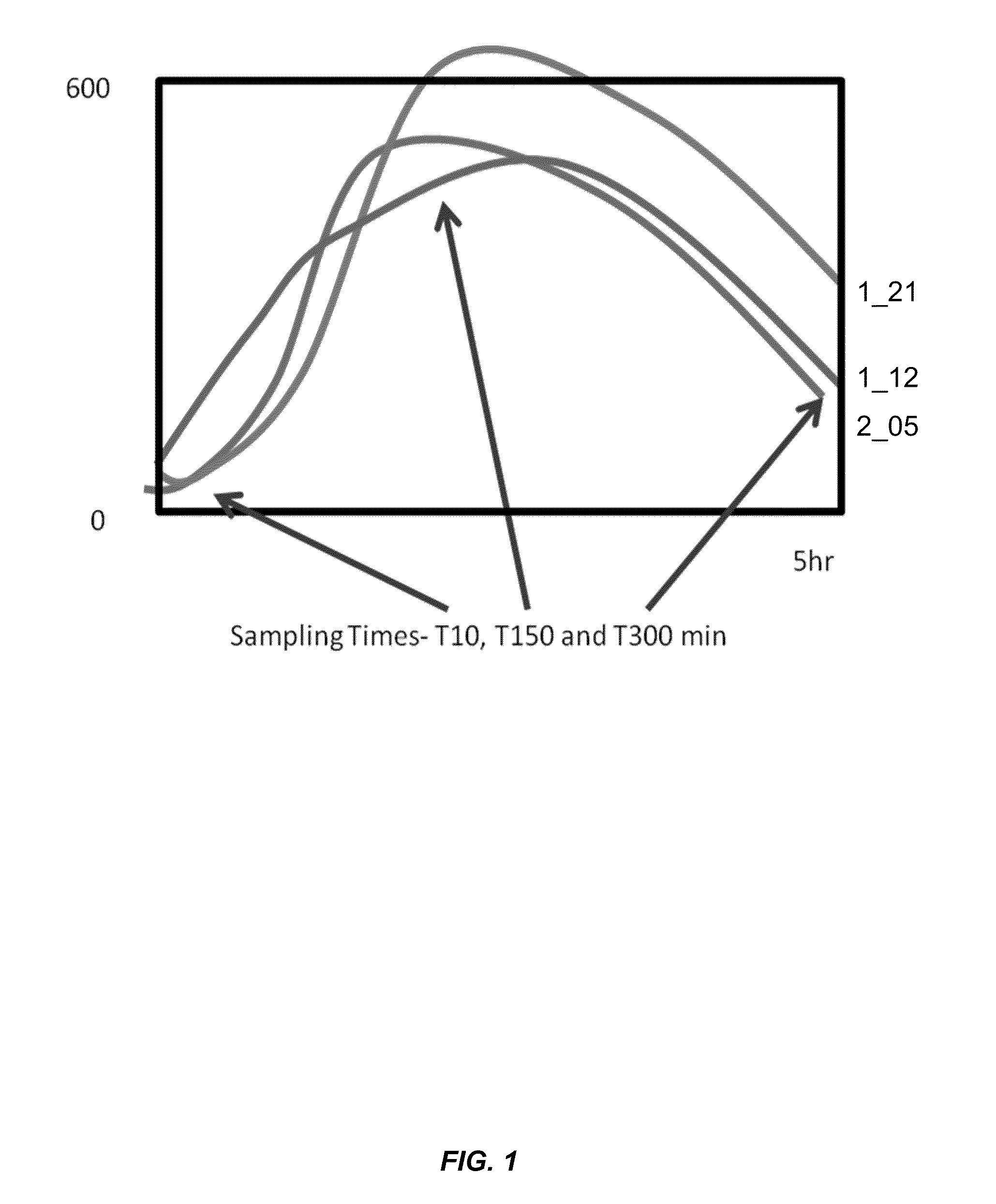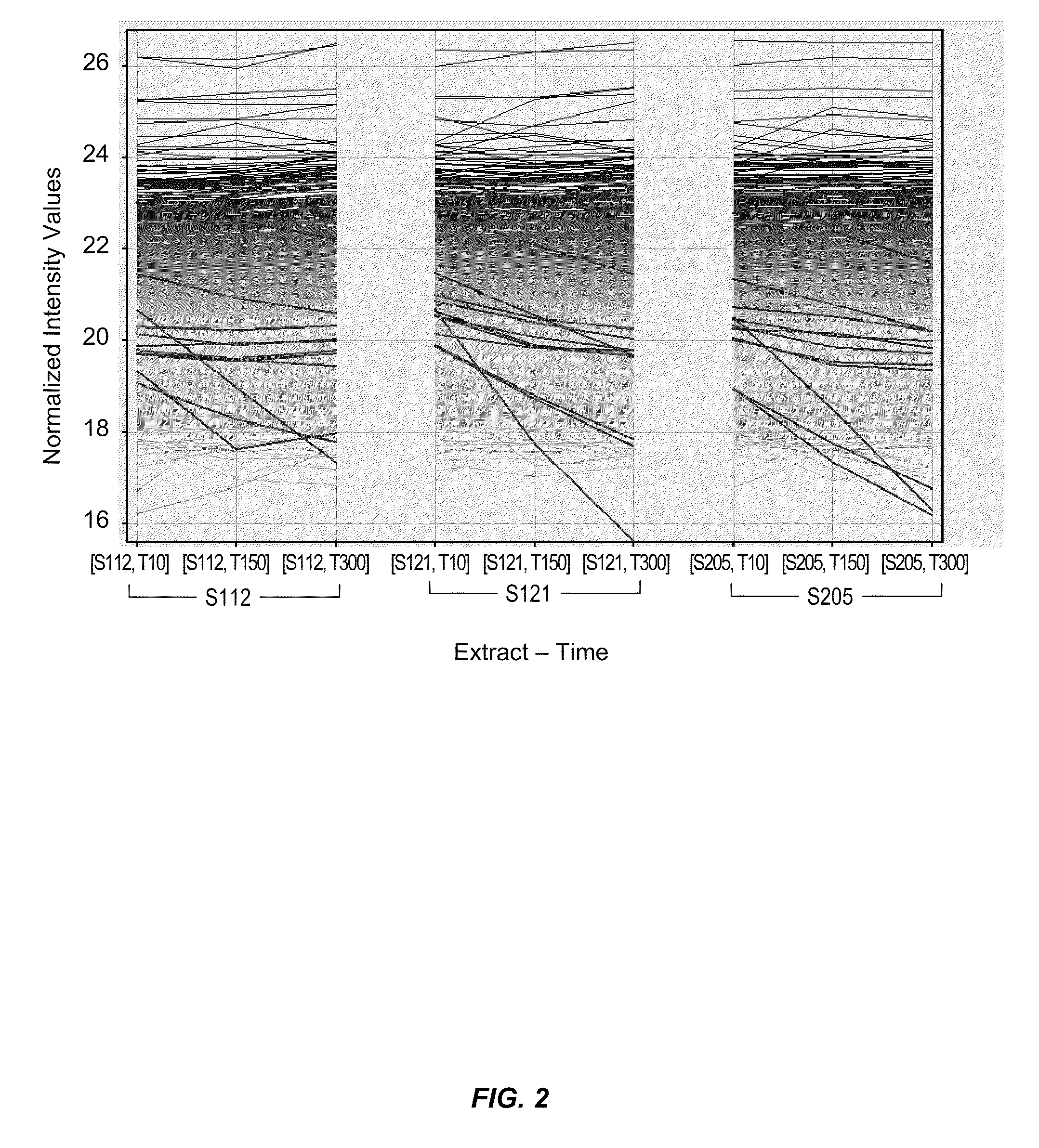Monitoring a dynamic system by liquid chromatography-mass spectrometry
a dynamic system and liquid chromatography technology, applied in the direction of instruments, transferases, peptides, etc., can solve the problems of negatively affecting additional proteins have been shown to negatively affect the efficiency of the cell-free protein synthesis system, etc., to achieve the effect of suppressing the level or amount of a cold shock protein, and enhancing recombinant protein
- Summary
- Abstract
- Description
- Claims
- Application Information
AI Technical Summary
Benefits of technology
Problems solved by technology
Method used
Image
Examples
example 1
Sampling and Analysis of Pre-incubation Time Points
[0109]FIG. 1 shows the protein yields for rhGM-CSF (Granulocyte macrophage colony stimulating factor) obtained during a 5 hr cell-free synthesis reaction from extracts prepared as a function of different pre-incubation times for 3 different extracts. An optimal pre-incubation time of ca. 2.5 hours is required to fully activate the extract. Without pre-incubation the extract is inactive (at time 0).
[0110]High throughput proteomic profiling of individual preincubation time point samples was carried out as follows. A 96-well plate sample preparation method was developed for reducing, alkylating, proteolysing and desalting the various time point samples. Digested peptides were separated and analyzed on an HPLC system interfaced to an electrospray ionization quadrupole-time of flight (ESI-QTOF 6520 from Agilent Technologies, Santa Clara, Calif.) mass spectrometer. Sixty LC-MS / MS experiments were conducted to identify ˜2000 proteins in th...
example 2
LC-MS Analysis of Extract Proteome to Identify Changing Protein Levels
[0111]Five microliters of bacterial extract was sufficient to profile ˜2000 proteins by 1DLC-MS without need for 2D separation. Label-free differential profiling based quantification was validated with spiked proteins. Related co-efficients of variation for sample processing and LC-MS were within 15% for majority of measurements. No retention time correction or intensity normalization was required due to high retention time and signal stability over multiple runs. Overall, a state-of-the-art sample preparation as well as LC-MS and LC-MS / MS based relative quantification platform was developed and validated for profiling ˜2000 proteins in crude bacterial lysates using commercially available hardware and software. Initially, about 400 proteins were profiled in the extracts. The majority of the proteins such as elongation factor Tu, elongation factor G, elongation factor Ts, pyruvate dehydrogenase, tRNA synthetases, c...
example 3
Addition of Cold Shock Proteins Inhibits Cell-Free Protein Synthesis
[0115]Cold shock proteins CspE and HNS were cloned and overexpressed in the cell-free system. Crude preparations of CspE and H—NS synthesized using cell-free reaction were added to a cell-free reaction to produce green fluorescent protein (GFP). A negative control was done using crude preparation of GM-CSF synthesized during cell-free reaction and added to a GFP cell-free reaction. The negative controls showed that the crude lysate background did not have any inhibitory effect with the no plasmid and the GMCSF lysates. However, the added crude lysates with expressed cold shock proteins were found to inhibit the cell-free reaction (FIG. 3). In the crude lysates experiment the maximum amount of HNS and CspE present was limited by their expression level, thus full inhibition was not observed. To see full inhibition these proteins were expressed in larger scale and purified. The pure protein was checked by LC-MS for cor...
PUM
| Property | Measurement | Unit |
|---|---|---|
| time | aaaaa | aaaaa |
| molecular mass | aaaaa | aaaaa |
| molecular mass | aaaaa | aaaaa |
Abstract
Description
Claims
Application Information
 Login to View More
Login to View More - R&D
- Intellectual Property
- Life Sciences
- Materials
- Tech Scout
- Unparalleled Data Quality
- Higher Quality Content
- 60% Fewer Hallucinations
Browse by: Latest US Patents, China's latest patents, Technical Efficacy Thesaurus, Application Domain, Technology Topic, Popular Technical Reports.
© 2025 PatSnap. All rights reserved.Legal|Privacy policy|Modern Slavery Act Transparency Statement|Sitemap|About US| Contact US: help@patsnap.com



